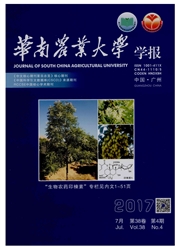

 中文摘要:
中文摘要:
以辣椒Capsicumannuum细胞质雄性不育系‘北A’及其保持系‘北B’、恢复系‘B162’和杂种F.为材料,采用间接酶联免疫(ELISA)检测技术测定分析了各材料不同发育时期花蕾中内源IAA、ABA、ZR;和GA3的含量和比值变化.结果表明,不育系‘北A’花蕾中IAA和ABA的含量在各个时期均显著高于相应的保持系和恢复系,而ZRs的含量则显著低于可育材料;GA3的含量在造孢细胞期至四分小孢子期呈缓慢降低的趋势,并且在四分小孢子期显著低于可育材料.不育系花蕾中IAA/ZRs、ABA/ZRs以及IAA/GA3的比值均高于相应的保持系和恢复系.初步认为花蕾中较高的IAA和ABA含量及较低的ZRs和GA3含量可能与辣椒细胞质雄性不育有关.
 英文摘要:
英文摘要:
Content of endogenous IAA, ABA, ZRs and GA3 in flower buds of Capsicum annuum, pepper CMS line ‘Bei-A' and maintainer line ‘Bei-B' ,restorer line ‘B162' and hybrid F1 during five development stages were measured by enzyme-linked immunosorbent assay (ELISA). The results showed that IAA and ABA contents of the sterile buds were higher, while ZRs content was lower than that of maintainer and restorer. GA3 content in buds of ‘Bei-A' decreased slowly from the stage of sporogenous cell to tetrad and was lower than that of fertile buds during the tetrad stage. The ratio of IAA/ZRs, ABA/ZRs and IAA/GA3 in sterility line were remarkably higher than that of maintainer and restorer line. It was speculated that the higher content of IAA and ABA and lower ZRs and GA3 of flower buds could have some relationships to pepper cytoplasmic male sterility.
 同期刊论文项目
同期刊论文项目
 同项目期刊论文
同项目期刊论文
 期刊信息
期刊信息
